词汇学 第4章要点 1 Derivation
- 格式:doc
- 大小:39.00 KB
- 文档页数:4


Key Points of “English Lexicology”Chapter 4Word Formation(1)The expansion of vocabulary in modern English depends chiefly on word-formation.The most productive means of word formation are affixation, compounding and conversion.Affixation: 30%-40%, compounding: 28%-30%, conversion: 26%, shortening (clipping and acronymy): 8%-10%, blending and others 1%-5%.Rules themselves are not fixed but undergo changes.There are always exceptions to rules of word-formation.4.1 AffixationAffixation is defined as the formation of words by adding word forming or derivational affixes to bases.According to their position, affixation falls into prefixation and suffixation.1. PrefixationPrefixation is the formation of new words by adding prefixes to bases. Prefixes do not change the word-class of the base but only change its meaning.The major prefixes can be classified into 10 categories by their meaning.1. Negative Prefixes否定前缀Of this group, un- is by far the most productive.2. Reversative or privative prefixes逆反(反向)前缀Prefixes of this group are repetition of most of the first set.3. Pejorative prefixes贬义前缀4. Prefixes of degree or size程度或大小前缀5. Prefixes of orientation and attitude倾向和态度前缀6. Locative prefixes方位前缀7. Prefixes of time and order时间和顺序前缀8. Number prefixes数字前缀9. Conversion prefixes转类前缀10. Miscellaneous prefixes其它前缀2. SuffixationSuffixation is the formation of new words by adding suffixes to bases.The primary function of suffixes is to change the grammaticalfunction of the base, i. e. the change of the word class with a slight modification of meaning.Suffixes can be grouped on a grammatical basis.If we call a suffix a noun suffix, that means when it is added to the base, whatever class it belongs to, the result will be a noun.1) Noun suffixes 名词后缀(1) Denominal nouns 从名词派生的名词Concrete: Noun base→Concrete nounAbstract: Noun base→Abstract noun(2) Deverbal nouns从动词派生的名词V erb base→agential noun (行为者名词)V erb base→abstract noun, denoting action, result, process, state, ect.(3) De-adjective nouns从形容词派生的名词(4) Nouns and adjectives suffixesBase→both nouns and adjectives2) Adjective suffixes(1) Denominal suffixes从名词派生的形容词(2) Deverbal suffixes从动词派生的形容词3) Adverb suffixes-wise表示“方向”、“样子”、“状态”、“在…方面”,现代英语中最后一种意义用得比较多,如:ostrich-wise 像鸵鸟一样地sleep-walker-wise像梦游者一样percetage-wise 就百分比来说calorie-wise 就卡路里来说educationwise 就教育方面来说weatherwise在气候方面taxwise 在赋税方面curriculumwise 就课程方面来说housingwise 就住房问题来看4) V erb suffixes补充:petrify 吓呆petroleum 石油fame 名声,声望infant 婴儿sist, stitut, sta, st=to stand(站立)assist, consist, exist, constituent, persist, stable, establish, obstacle, static, statue, circumstance, distant, ecstasy, prostitute。
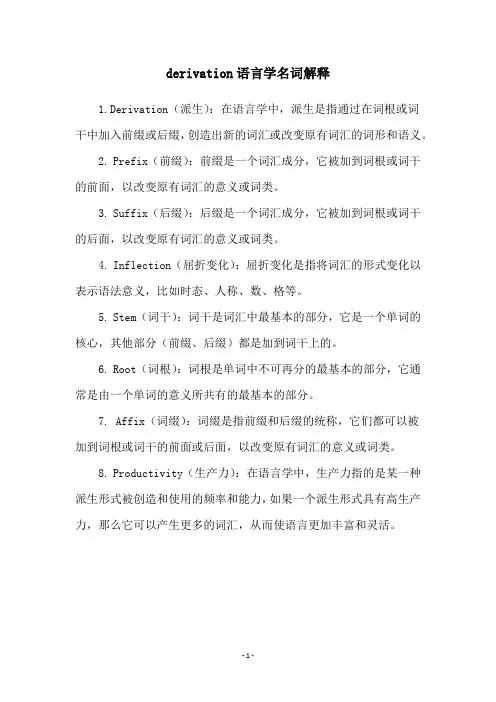
derivation语言学名词解释
1.Derivation(派生):在语言学中,派生是指通过在词根或词
干中加入前缀或后缀,创造出新的词汇或改变原有词汇的词形和语义。
2. Prefix(前缀):前缀是一个词汇成分,它被加到词根或词干的前面,以改变原有词汇的意义或词类。
3. Suffix(后缀):后缀是一个词汇成分,它被加到词根或词干的后面,以改变原有词汇的意义或词类。
4. Inflection(屈折变化):屈折变化是指将词汇的形式变化以表示语法意义,比如时态、人称、数、格等。
5. Stem(词干):词干是词汇中最基本的部分,它是一个单词的核心,其他部分(前缀、后缀)都是加到词干上的。
6. Root(词根):词根是单词中不可再分的最基本的部分,它通常是由一个单词的意义所共有的最基本的部分。
7. Affix(词缀):词缀是指前缀和后缀的统称,它们都可以被
加到词根或词干的前面或后面,以改变原有词汇的意义或词类。
8. Productivity(生产力):在语言学中,生产力指的是某一种派生形式被创造和使用的频率和能力,如果一个派生形式具有高生产力,那么它可以产生更多的词汇,从而使语言更加丰富和灵活。
- 1 -。
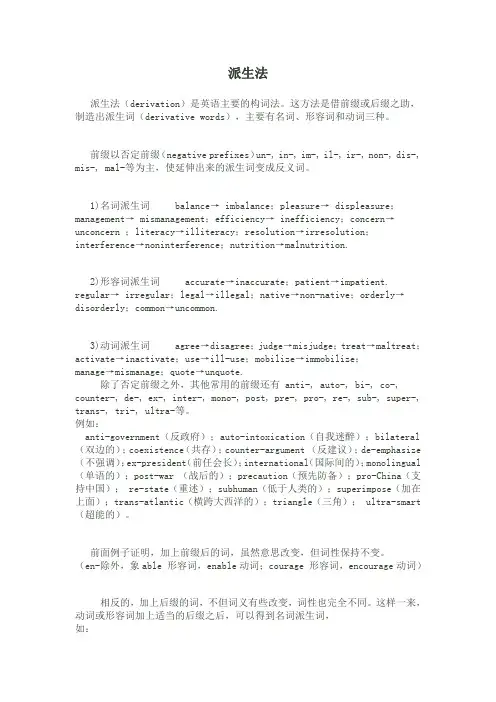
派生法派生法(derivation)是英语主要的构词法。
这方法是借前缀或后缀之助,制造出派生词(derivative words),主要有名词、形容词和动词三种。
前缀以否定前缀(negative prefixes)un-, in-, im-, il-, ir-, non-, dis-, mis-, mal-等为主,使延伸出来的派生词变成反义词。
1)名词派生词balance→ imbalance;pleasure→ displeasure;management→ mismanageme nt;efficiency→ inefficiency;concern→ unconcern ;literacy→illiteracy;resolution→irresolution;interference→noninterference;nutrition→malnutrition.2)形容词派生词accurate→inaccurate;patient→impatient. regular→ irregular;legal→illegal;native→non-native;orderl y→ disorderly;common→uncommon.3)动词派生词agree→disagree;judge→misjudge;treat→maltreat;activate→inactivate;use→ill-use;mobilize→immobilize;manage→mismanage;quote→unquote.除了否定前缀之外,其他常用的前缀还有 anti-, auto-, bi-, co-, counter-, de-, ex-, inter-, mono-, post, pre-, pro-, re-, sub-, super-, trans-, tri-, ultra-等。
例如:anti-government(反政府);auto-intoxication(自我迷醉);bilateral (双边的);coexistence(共存);counter-argument (反建议);de-emphasize (不强调);ex-president(前任会长);international(国际间的);monolingual (单语的);post-war (战后的);precaution(预先防备);pro-China(支持中国); re-state(重述);subhuman(低于人类的);superimpose(加在上面);trans-atlantic(横跨大西洋的);triangle(三角); ultra-smart (超能的)。
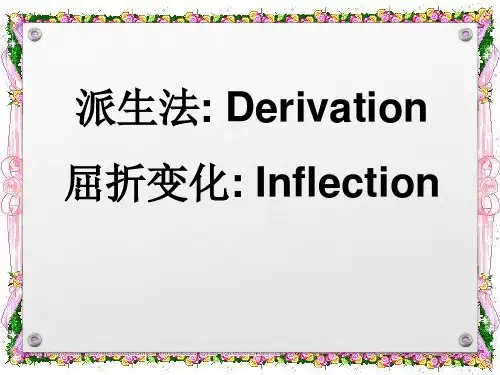
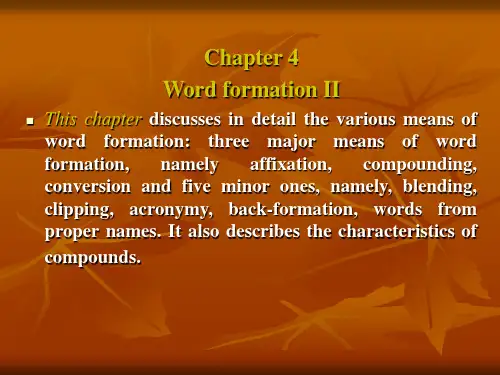
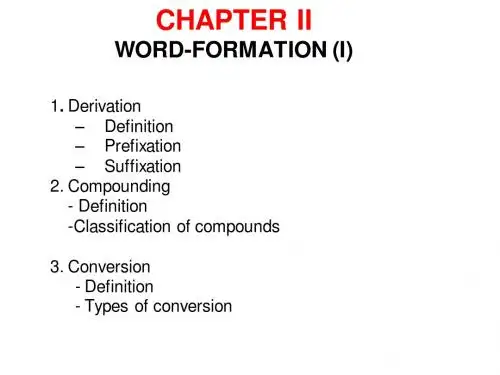
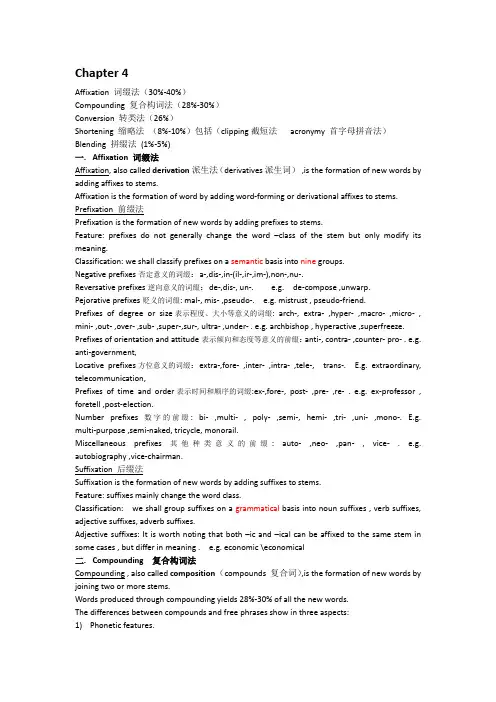
Chapter 4Affixation 词缀法(30%-40%)Compounding 复合构词法(28%-30%)Conversion 转类法(26%)Shortening 缩略法(8%-10%)包括(clipping截短法acronymy 首字母拼音法)Blending 拼缀法(1%-5%)一.Affixation 词缀法Affixation, also called derivation派生法(derivatives派生词),is the formation of new words by adding affixes to stems.Affixation is the formation of word by adding word-forming or derivational affixes to stems. Prefixation 前缀法Prefixation is the formation of new words by adding prefixes to stems.Feature: prefixes do not generally change the word –class of the stem but only modify its meaning.Classification: we shall classify prefixes on a semantic basis into nine groups.Negative prefixes否定意义的词缀:a-,dis-,in-(il-,ir-,im-),non-,nu-.Reversative prefixes逆向意义的词缀:de-,dis-, un-. e.g. de-compose ,unwarp.Pejorative prefixes贬义的词缀: mal-, mis- ,pseudo-. e.g. mistrust , pseudo-friend.Prefixes of degree or size表示程度、大小等意义的词缀: arch-, extra- ,hyper- ,macro- ,micro- , mini- ,out- ,over- ,sub- ,super-,sur-, ultra- ,under- . e.g. archbishop , hyperactive ,superfreeze. Prefixes of orientation and attitude表示倾向和态度等意义的前缀:anti-, contra- ,counter- pro- . e.g. anti-government,Locative prefixes方位意义的词缀:extra-,fore- ,inter- ,intra- ,tele-, trans-. E.g. extraordinary, telecommunication,Prefixes of time and order表示时间和顺序的词缀:ex-,fore-, post- ,pre- ,re- . e.g. ex-professor , foretell ,post-election.Number prefixes数字的前缀: bi- ,multi- , poly- ,semi-, hemi- ,tri- ,uni- ,mono-. E.g. multi-purpose ,semi-naked, tricycle, monorail.Miscellaneous prefixes其他种类意义的前缀: auto- ,neo- ,pan- , vice- . e.g. autobiography ,vice-chairman.Suffixation 后缀法Suffixation is the formation of new words by adding suffixes to stems.Feature: suffixes mainly change the word class.Classification: we shall group suffixes on a grammatical basis into noun suffixes , verb suffixes, adjective suffixes, adverb suffixes.Adjective suffixes: It is worth noting that both –ic and –ical can be affixed to the same stem in some cases , but differ in meaning . e.g. economic \economical二.Compounding 复合构词法Compounding , also called composition(compounds 复合词),is the formation of new words by joining two or more stems.Words produced through compounding yields 28%-30% of all the new words.The differences between compounds and free phrases show in three aspects:1)Phonetic features.2)Semantic features.3)Grammatical features.Formation of compounds1)Noun compoundse.g. Sit-in ,stockholder , up-bringing2)Adjective compoundse.g. law-abiding , record-breaking ,town-bred , four-leg.3)Verb compoundsThe limited number of verb compounds are created either through conversion or backformation. Verb compounds in the way of back-formation are formed mainly by dropping the suffixes:-er, -ing, -ion , etc.三.Conversion 转类法Conversion is the formation of new words by converting words of one class to another class. Conversion is a method of turning words of one part of speech to those of a different part of speech.1.An alternative for conversion is functional shift.2.The derivational process , in which an item is converted to a new word class without theaddition of an affix , is called zero-derivation .3.Words produced by conversion are primarily nouns , adjectives ,and verbs.The most productive conversion is the conversion that takes place between nouns and verbs.4.Full conversion and partial conversion are concerned with adjectives when converted tonouns.1)Full conversion: A noun fully converted from an adjective has all the characteristics ofnouns . It can take an indefinite article or –(e)s to indicate singular or plural number.2)partial conversion: nouns partially converted from adjectives do not possess all thequalities a noun does. They must be used together with definite articles.3)Such words as “the poor ”,”the richer ”,”the most corrupt” are all examples of partial. 5.The conversion of two syllable nouns into verbs involves a change of stress.双音节的名词转化成动词会有重音的变化。
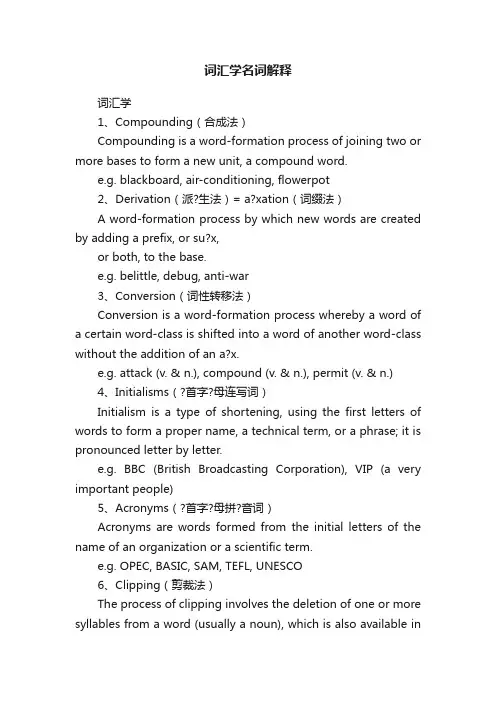
词汇学名词解释词汇学1、Compounding(合成法)Compounding is a word-formation process of joining two or more bases to form a new unit, a compound word.e.g. blackboard, air-conditioning, flowerpot2、Derivation(派?生法)= a?xation(词缀法)A word-formation process by which new words are created by adding a prefix, or su?x,or both, to the base.e.g. belittle, debug, anti-war3、Conversion(词性转移法)Conversion is a word-formation process whereby a word of a certain word-class is shifted into a word of another word-class without the addition of an a?x.e.g. attack (v. & n.), compound (v. & n.), permit (v. & n.)4、Initialisms(?首字?母连写词)Initialism is a type of shortening, using the first letters of words to form a proper name, a technical term, or a phrase; it is pronounced letter by letter.e.g. BBC (British Broadcasting Corporation), VIP (a very important people)5、Acronyms(?首字?母拼?音词)Acronyms are words formed from the initial letters of the name of an organization or a scientific term.e.g. OPEC, BASIC, SAM, TEFL, UNESCO6、Clipping(剪裁法)The process of clipping involves the deletion of one or more syllables from a word (usually a noun), which is also available inits full form.e.g. plane from airplane, phone from telephone, gym from gymnastics, taxi from taxicab7、Blending(混合法)Blending is a process of word-formation in which a new word is formed by combining the meanings and sounds of two words, one of which is not in its full form or both of whichare not in their full forms.e.g. newscast (news + broadcast), brunch (breakfast + lunch)8、Back formation(逆构法)Back-formation is a term used to refer to a type of word-formation by which a shorterword is coined by the deletion of a supposed a?x from a longer form already present in the language.e.g.the verb resurrect was formed from the noun resurrection by removing the supposed derivative su?x -ion, and the verb edit formed from editor by dropping the su?x -or.9、Words from proper names(专有名词构词法)The words that coined from the di?erent proper names. Such as the names of people, the names of places, the names of books, or the names of brands.e.g. watt, hertz, Nicotine10、Reduplication(复制法)Reduplication is a minor type of word-formation by which a compound word is created by the repetition (1)of one word like go-go; (2)of two almost identical words with a change in the vowel’s such as ping-pong; (3) of two almost identical words with a change in the initial consonants, as in teenyweeny.11、Coinage(新造的字)Coinage is a process of inventing words not based onexisting morphemes.e.g. fruice = fruit +juice, slanguage =slang + language12、Classification of English words according to di?erent criteriaA. By origin:1) native words2) loan wordsB. By level of usage :1)common words2)literary words3)colloquial words4)slang words5)technical wordsC. By notion:1)function words(虚词)2)content words (实词)13、inflectional morpheme (or inflectional a?xes) (曲折词缀)An inflectional aifix serves to express such meanings as plurality, tense, and the comparative or superlative degree. It does not form a new word with new lexical meaning when it is added to another word. Nor does it change the word-class of the word to which it is a?xed.e.g. “s” in chairs, pens ; “es” in boxes, tomatoes;“en” in oxen14、root(词根)(1) 书:A root is the basic unchangeable part of a word, and it conveys the main lexical meaning of the word.e.g. work, boy, moon, walk(2) ?网:A root is a form which is not further analysable, either in terms of derivational or inflectional morphology. A rootis the basic part always present in a lexeme.15、stem(词?干)Stem is the part of the word-form which remains when all inflectional a?xes have been removed.e.g. in the word undesirables, the stem is undesirable;in the word desired, the stem is desire16、base(词基)Base is any form to which a?xes of any kind can be added.e.g. in the word desirable, desire is the base to which a su?x -able is added.17、echoic words or onomatopoeic words(拟声词或象声词)Words motivated phonetically are called echoi words or onomatopoeic words, whose pronunciation suggests the meaning.e.g. the woof-woof of a dog, the miaow of a cat18、homonyms(异义词)In the English language, there are many pairs or groups of words, which, though di?erent in meaning, are pronounced alike, or spelled alike, or both.e.g. lead (n. & v.), sow (n. & v.), tear (n. & v.)19、complementary antonyms(互补性反义词)Complementaries or contradictories represent a type of binary semantic opposition. In a complementary pair the contrast between the two terms is absolute.e.g. alive and dead, single and married20、synchronic dictionary(共时词典)Synchronic dictionaries describe the vocabulary of a certain period or at a certain stage of the development of the language, providing the from, meaning, usage, etc., of the words of the period.e.g. COD, WCD21、allomorph(同位异形体)An allomorph is any of the variant forms of a morpheme as conditioned by position or adjoining sounds.e.g. the allomorphs -ion/-tion/-sion/-ation are the positional variants of the same su?x22、prefixation(前缀)Prefixation is the formation of new words by adding a prefix or combining form to the base.e.g. de-, be-, en-23、semantic motivation(语义动机)Semantic motivation refers to motivation based on semantic factors. It is a kind of mental association.e.g.When we speak of a stony heart we are comparing the heart with a stone; when we say the leg of a table, we are comparing the tables leg with one of the lower limbs of a human being.24、a?ective meaning(情感意义)A?ective meaning is concerned with the expression of feelings and attitudes of the speaker or writer.e.g. Aha! Alas! and Hurrah!25、hyponymy(上下义关系)Hyponymy is the relationship which obtains between specific and general lexical items, such that the former is “included” in the la tter.e.g. a cat is a hyponym of animal, flute of instrument, chair of furniture26、semantic field(语义场)(1)书:Semantic field theory "took the view that the vocabulary of a given language is not simply a listing ofindependent items (as the headwords in a dictionary would suggest), but is organized into areas, or fields, within which words interrelate and define each other in various ways."(2)?网:Semantic field theory is concerned with the vocabulary of a language as a system of interrelated lexical networks. The words of a semantic field are joined together by a common concept, and they are likely to have a number of collocations in common.e.g.The words red, green, white etc. make up the semantic field of colors;the words father, mother, son etc. make up the semantic field of kinship27、componential analysis(成分分析法)The analysis of word meanings is often seen as a process of breaking down the sense of a word into its minimal components.e.g. cow : [+ Bovine + Adult - Male]man : [+Human + Adult + Male]。
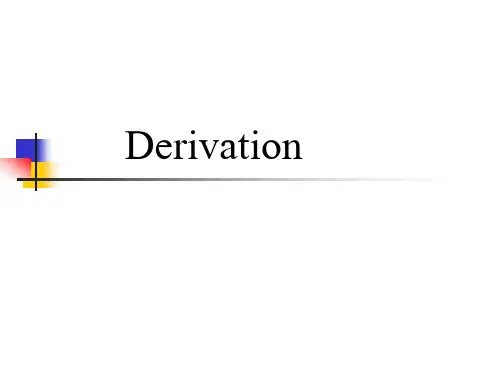
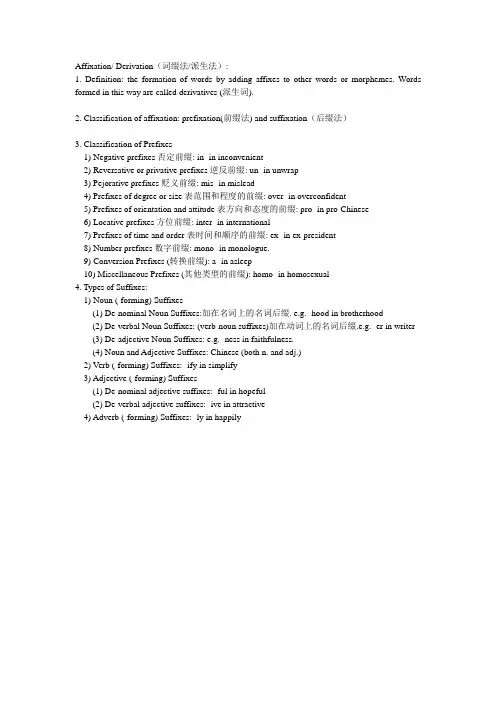
Affixation/ Derivation(词缀法/派生法):1. Definition: the formation of words by adding affixes to other words or morphemes. Words formed in this way are called derivatives (派生词).2. Classification of affixation: prefixation(前缀法) and suffixation(后缀法)3. Classification of Prefixes1) Negative prefixes否定前缀: in- in inconvenient2) Reversative or privative prefixes逆反前缀: un- in unwrap3) Pejorative prefixes贬义前缀: mis- in mislead4) Prefixes of degree or size表范围和程度的前缀: over- in overconfident5) Prefixes of orientation and attitude表方向和态度的前缀: pro- in pro-Chinese6) Locative prefixes方位前缀: inter- in international7) Prefixes of time and order表时间和顺序的前缀: ex- in ex-president8) Number prefixes数字前缀: mono- in monologue.9) Conversion Prefixes (转换前缀): a- in asleep10) Miscellaneous Prefixes (其他类型的前缀): homo- in homosexual4. Types of Suffixes:1) Noun (-forming) Suffixes(1) De-nominal Noun Suffixes:加在名词上的名词后缀. e.g. -hood in brotherhood(2) De-verbal Noun Suffixes: (verb-noun suffixes)加在动词上的名词后缀.e.g. -er in writer(3) De-adjective Noun Suffixes: e.g. -ness in faithfulness.(4) Noun and Adjective Suffixes: Chinese (both n. and adj.)2) Verb (-forming) Suffixes: -ify in simplify3) Adjective (-forming) Suffixes(1) De-nominal adjective suffixes: -ful in hopeful(2) De-verbal adjective suffixes: -ive in attractive4) Adverb (-forming) Suffixes: -ly in happily。
derivation构词法
构词法(Derivation)是一种词汇形成方法,它通过将已存在的词汇,结合有规律的词汇构成方法,构造出新词汇。
构词法是词汇形成的重要手段,是词汇形成的核心过程。
构词法分为三种:附着式构词法、合成式构词法和派生式构词法。
附
着式构词法是指借用短语或其他词语改变词义来构成新的词汇,如
“by+bus” → “bybus”;合成式构词法是指把两个或多个单独存在的
词组合在一起组成新的词汇,如“rain +bow”→“rainbow”;派生式构
词法是指通过添加词缀、词根或词干,来改变新词语的语义,如“happy” + “ly” → “happily”。
构词法提供了一种简单而快捷的词汇表达方式,使语言更加活泼和多样,也为语言发展带来了极大便利。
构词法虽然简单,但是却是词汇形成
的核心。
掌握构词法,可以节省极大的精力,还可以有效的掌握汉语的写
作和表达。
由此可见,掌握构词法对提高语言素养和表达能力是必不可少的。
derivation 词根【实用版】目录1.词根的定义和作用2.词根"derivation"的含义和来源3."derivation"在英语中的应用和例子4."derivation"与其他词根的比较正文词根是词汇的基本单位,它是词汇构成的基础,可以通过添加前缀、后缀或其他词缀来形成新的词汇。
在英语词汇学中,词根研究是一项重要的内容,它可以帮助我们更好地理解和使用英语词汇。
"derivation"这个词根来自拉丁语"derivare",意为"引导、获得、引出"。
在英语中,"derivation"通常用于描述词汇的来源和演变过程。
比如,"differential"(微分)和"difference"(差异)这两个词就是通过在"differ"(区别)这个单词的基础上添加前缀和后缀演变而来的。
"derivation"在英语中有广泛的应用,它是英语词汇构成的重要组成部分。
许多英语单词都是通过"derivation"这个过程形成的,比如"derivative"(派生的)、"derivatively"(派生地)等。
与其他词根相比,"derivation"更注重词汇的演变过程,而其他词根则更注重词汇的意义。
比如,"bio-"(生命)和"chron-"(时间)这两个词根,它们分别表示生命的和时间的意义,而不是描述词汇的演变过程。
总的来说,"derivation"是一个重要的词根,它对英语词汇的构成和演变起着重要的作用。
第1页共1页。
English Lexicology(英语词汇学)Lexicology(词汇学): is a branch of linguistics, inquiring into the origins and meanings of words.The Nature and Scope of English lexicology:English lexicology aims at investigating and studying the morphological structures of English words and word equivalents, their semantic structures, relations, historical development, formation and usages.The subjects that English Lexicology correlated with and extent to:English Lexicology is correlated with such linguistic disciplines as morphology(形态学), semantics(语义学), etymology(词源学),stylistics(文体论)and lexicography(词典学) The reason for a student to study English lexicology:According to the textbook, English Lexicology will definitely be beneficial for students of English.A good knowledge of morphological structures of English words and rules ofword-formation will help learners develop their personal vocabulary and consciously increase their word power. The information of the historical development and the principles of classification will give them a deeper understanding of word-meaning and enable them to organize, classify and store words more effectively. The understanding and their sense relations will gradually raise their awareness of meaning and usage, and enable them use words more accurately and appropriately. A working knowledge of dictionaries will improve their skills of using reference books and raise their problem-solving ability and efficiency of individual study.Chapter 1--Basic concepts of words and vocabularyWord(词的定义): A word is a minimal free form of a language that has a given sound and meaning and syntactic function. (1)a minimal free form of a language (2)a sound unity (3)a unit of meaning (4)a form that can function alone in a sentenceSound and meaning(声音与意义): almost arbitrary, “no logical relationship between the sound which stands for a thing or an idea and the actual thing and idea itself”Sound and form(读音和形式):不统一的四个原因(1)the English alphabet was adopted from the Romans,which does not have a separate letter to represent each other (2)the pronunciation has changed more rapidly than spelling over the years(3)some of the difference were creates by the early scribes(4)the borrowings is an important channel of enriching the English vocabularyVocabulary(词汇): all the words in a language make up its vocabularyClassification of English Words:By use frequency:basic word stock&nonbasic vocabularyBy notion:content words&functional wordsBy origin:native words&borrowed wordsThe basic word stock(基本词汇): is the foundation of the vocabulary accumulated over centuries and forms the common core of the language. Though it constitute a small percentage of the EV, it is the most important part of vocabulary.The Fundamental Features of the Basic Word Stock(基本词汇的特征):1)All-National character(全民通用性most important)2)Stability(相对稳定性)3)Productivity(多产性)4)Polysemy(多义性)5)Collocability(可搭配性)没有上述特征的words:(1)Terminology(术语) (2)Jargon(行话)(3)slang(俚语)(4)Argot(暗语)(5)Dialectal words(方言) (6) Archaisms(古语)(7) Neologisms(新词语):Neologisms means newly-created words or expressions, or words that have taken on new meanings.(email)Content words/notional words实词(cloud, run walk, never, five, frequently) and functional words/empty words虚词(on, of, and, be, but)Native Words and Borrowed WordsNative words(本族语词): known as Anglo-Saxon words (50,000-60,000), are words brought to Britain in the 5th century by the Germanic tribes. (mainstream of the basic word-stocks).Two other features:(1)neutral in style (2)frequent in useBorrowed words/Loan words(外来语词): words taken over from foreign languages.(80% of modern EV)4 Types of loan words:1) denizens(同化词): (shirt from skyrta(ON))2) aliens(非同化词/外来词):are borrowed words which have retained their original pronunciation and spelling (kowtow (CH)磕头)3) translation loans(译借词):按其他语言方式组成英语long time no see (from China)4) semantic loans(借义词):they are not borrowed with reference to the form,but their meanings are borrowedChapter 2 the development of the English VocabularyThe Indo-European Language Family(印欧语系)The Eight Groups in Indo-European Family of Languages(8大印欧语群)The Eastern set:(1)The Balto-slavic Group(波罗的-斯拉夫语族):Russian,Bulgarian,Polish,Czech etc. (2)The Indo-Iranian Group(印度-伊朗语族):Hindi,Bengali,Persian etc.(3)The Armenian Group(亚美尼亚语族):Armenian.(4)The Albanian Group(阿尔巴尼亚语族):Albanian.The Western set:(5)The Hellenic Group(古希腊语族):Greek.(6)The Italian Group(意大利语族):Latin ,Romance languages(French,Italian,Spanish, portuguese,Romanian) etc.(7)The Celtic Group(凯尔特语族):Irish,Welsh,Breton etc.(8)The Germanic Group(日耳曼语族):Flemish,German,Dutch,Scandinavian(Norweigian, Swedish,Danish,Icelandic) etc.The Three Stages of Development of the English Vocabulary:1 Old English (450-1100) (vocabulary 50,000 to 60,000):was I high inflected language.2 Middle English (1150-1500):retaines much fewer inflections3 Modern English (1500-up to now): in fact more than 25% of modern E words come almost directly from classical languages. In Modern E, words endings were mostly lost with just a few expections.English has evolved from a synthetic language(Old English) to the present analytic language.Modes of Vocabulary Development(词汇的发展模式):1)creation创造新词:the formation of new words by using the existing materials,namely toots,affixes and other elements.(最重要方式)2)semantic change旧词新义:does not increase the number of word forms but create many more new useages of the words.3) borrowing借用外来词:constitute merely 6 to 7 percent of all new wordsReviving words or obsolete words also contributes to the growth of English vocabulary though quite insignificant.Chapter 3 Word Formation IMorpheme(词素):the smallest functioning unit in the composition of words Allomorph(词素变体): is a different variant form of a morpheme,differ in phonological and spelling form, but at the same in function and meaningType of Morpheme(词素的分类)(1)Free Morphemes(自由词素): have complete meaning in themselves and can be used as free grammatical units in sentences. A free morpheme is one that can stand by itself. (independent).(2)Bound Morpheme(粘着语素): A bound morpheme is one that cannot stand by itself. Bound Morpheme includes two types: (1) bound root(粘附词根) (2)Affix(词缀)Affixes can be put into two groups:1)Inflectional affixes (屈折词缀):affixes attached to the end of words to indicate grammatical relationships are inflectional,thus known as inflectional morphemes.2)Derivational affixes(派生词缀): A) prefix: A prefix comes before words. B)suffix:An adjective suffix(形容词后缀)that is added to the stem, whatever class is belongs to , the result will be an adjective.Free Morpheme =free root(自由词根)Morpheme(词素)Bound root prefixbound derivationalaffix suffixinflectionalRoot and stem(词根和词干)The differences between root and stem:A root is the basic form of a word which cannot be further analyzed without total loss of identity.A stem is the surplus part after the cutting of inflectional morpheme in a word with inflectional morphemes,can be further analyzed, it sometimes could be a root.Chapter 4 Word-Formation II(构词法)1.Affixation词缀法(Derivation派生法):the formation of words by adding word-formaing or derivational affixes to stem.(1)Prefixation(前缀法):It's the formation of new words by adding a prefixes to stems.1)Negative prefixes(否定前缀): un-,non-,in-,dis,a- ,il-,ir-,im-,etc.disobey(not obey)2)Reversative prefixes(逆反前缀): un-,de-,dis- etc. unwrap(open)3) Pejorative prefixes: mis(贬义前缀):mis-,mal-, pseudo- etc.misconduct(bad behaviour)4) Prefixes of degree or size(程度前缀):arch-,extra-,hyper-,macro-,micro-,mini-,out-,over-,sub-,super-,sur-,ultra-,under-,ect. overweight5) Prefixes of orientation and attitude(倾向态度前缀):contra-,counter-,anti-,pro- etc.anti-nuclear6)Locative prefixes(方位前缀):extra-,fore-,inter-,intra-,tele-,trans-, etc. extraordinary(more than ordinary)7) Prefixes of time and order(时间和顺序前缀):fore-,pre-,post-,ex-,re- etc. monorail(one rail)8) Number prefixes(数字前缀):uni-,mono-, bi-,di-, tri-,multi-,poly- ,semi-,etc.bilingual(concerning two languages)9) Miscellaneous prefixes(混杂前缀):auto-, neo-, pan-, vice-.vice-chairman(deputy chairman)(2)Suffixation(后缀法): It's the formation of a new word by adding suffixes to stems.1)noun suffixes 2)adjective suffixes 3)Adverb suffixes 4)verb suffixespounding复合法(also called composition)Compounding: is the formation of new words by joining two or more stemsCompounds are written in three ways: solid连写(airmail),hyphenated带连字符(air-conditioning)and open分开写(air force, air raid)Formation of compounds(复合词的形式)(1)noun compounds :e.g. : air + plane = airplane,flower + pot = flower pot(2)adjective compounds :e.g. acid + head = acid-head(3)verb compounds :e.g. house + keep = housekeep3.Conversion转类法Conversion: is the formation of new words by converting words of one class to another class.(功能转换,又叫零派生.functional shift/zero-derivation)4.Blending拼缀法Blending : is the formation of new words by combining parts of two words or a word plus a part of another word. e.g: motor + hotel = motel, smoke + fog = smog, formula + translation = FORTRAN5.Clipping截短法Clipping:is to shorten a longer word by cutting a part off the original and using what remains instead.e.g. plane from airplane, phone from telephone. 四种形式:1).Front clippings删节前面(phone from telephone)2).Back clippings删节后面(dorm from dormitory)3).Front and back clippings 前后删节(flu from influenza)4).Phrase clippings 短语删节(pop from popular music)6.Acronymy首字母缩写法Acronymy:is the process of forming new words by joining the initial letters of names of social and political organizations or special noun phrases and technical terms.(1)Initialism(首字母缩写词法): initialisms are words pronounced letter by letter. e.g.: BBC(for British Broadcasting corporation)(2)Acronym(首字母拼音法):Acronyms are words formed from initial letters but pronounced as a normal word. E.g.:TEFL(teaching English as a foreign language)7.Back-formation(逆生法,逆构词)Back-formation is considered to be the opposite process of suffixation. It’s the method of creating words by removing the supposed suffixes. (greed from greedy)8.Words From Proper Name(专有名词转成法):Names of people, places, book, and tradenames (e.g.: sir watt siemens(人名) -- watt(瓦特,电功率单位)Chapter 5 Word MeaningThe meanings of “Meaning”(“意义”的意义)Reference(所指):It is the relationship between language and the word. It is the arbitrary and conventional. It is a kind of abstraction, yet with the help of context, it can refer to something specific.Concept(概念):which is beyond language, is the result of human cognition(认识),reflecting the objective world in the human mind.Sense(意义):It denotes the relationship inside the language. ‘The sense of an expression is its place in a system of semantic relat ionships with other expressions in the language.’Motivation(理据):It accounts for the connection between the linguistic symbol and its meaning.1) Onomatopoeic motivation(拟声理据):words whose sounds suggest their meaning, for these words were creates by imitating the natural sounds or noises. Knowing the sounds of the words means understanding the meaning. E.g.: bang, ping-pong, ha ha.2)Morphological motivation (形态理据):multi-morphemic words and the meaning of many are the sum total of the morphemes combines. E.g.: airmail, miniskirt .例外:black market, ect.3)Semantic motivation(词义理据):refers to the mental associations suggested by the conceptual meaning of a word. It explains the connection between the literal sense and figurative sense of the word. E.g:the foot of the mountain(foot)4)Etymological motivation (词源理据):the history of the word explains the meaning of the word. E.g:pen-featherTypes of meaning(词义的类别)1.Grammatical Meaning(语法意义):indicates the grammatical concept or relationships (becomes important only in actual context)2.Lexical Meaning (词汇意义)(Lexical meaning and grammatical meaning make up the word-meaning)Lexical meaning has 2 components内容: Conceptual meaning(概念意义) and associative meaning(关联意义)1)Conceptual meaning(概念意义): also known as denotative meaning(外延意义) is the meaning given in the dictionary and forms the core of word-meaning.2)Associative meaning(关联意义):is the secondary meaning supplemented to the conceptual meaning.[4types:(1)Connotative(内涵意义):the overtones or associations suggested by the conceptual meaning, traditionally known as connotations.(例如“母亲”经常与“爱”“关心”“温柔”联系起来)(2)Stylistic(文体意义):many words have stylistic features, which make them appropriate for different contexts.(3)Affective(感情意义):indicates the speaker’s attitude towards the person or thing in question.这种情感价值观分两类:褒义和贬义appreciative & pejorative(4)Collocative(搭配意义):is the part of the word-meaning suggested by the words before or after the word in discussion.]Chapter 6 --Sense relation and semantic field(语义关系和语义场)Polysemy(多义关系)Two approached to polysemy(多义关系的两种研究方法):1.diachronic approach(历时方法) :from the diachronic point of view, polysemy is assumed to be the result of growth and development of the semantic structure of one and same word. First meaning is the primary meaning , the later meanings are called derived meanings.2. synchronic approach (共时方法) : synchronically, polysemy is viewed as the coexistence of various meanings of the same word in a certain historical period of time.基本意义是central meaning , 次要意义是derived meaning.Two processes of development(词义的两种发展类型):1.radiation(辐射型):is a semantic process in which the primary meaning stands at thecentre and the secondary meanings proceed out of it in every direction like rayes. (e.g: face, neck)2.concatenation(连锁型):is the semantic process in which the meaning of a word movegradually away from its first sense by successive shifts until there is not a sign of connection between the sense that is finally developed and that which the term had at the beginning.(e.g:treacle)3.In radiation, each of the derived meaning is directly connected to the primary meaning.In concatenation, each of the later meaning is related only to the preceding one like chains. Though the latest sense can be traced back to the original, there is no direct connection in between.4.They are closely related, being different stages of the development leading topolysemy. Generally, radiation precedes concatenation. In many cases, the two processes work together, complementing each other.Homonymy(同形同音异义关系):words different in meaning but either identical both in sound and spelling or identical only in sound or spelling.Types of homonyms(同音同形异义关系的类别)1)Perfect homonyms(完全同音同形异义词):words identical both in sound and spelling, but different in meaning.2)Homographs(同形异义词):words identical only in spelling, but different in sound and meaning.(最多最常见)3)Homophones(同音异义词):words identical only in sound but different in spelling and meaning.Origins of homonyms (同形同音异义词的来源)1)change in sound and spelling :(eare-ear, lang-long, langian-long)2)borrowing (feria-fair, beallu-ball, baller-ball )3)Shortening(缩略): (ad-advertisement,)The differentiation of Homonyms from Polysemes(同音同形异义词和多义词的区别):1)The fundamental difference : Homonymy refers to different words which happen to share the same form and polysemy are the one and same word which has several distinguishable meanings.2)One important criterion is to see their etymology(词源):Homonymys are from different sources. Polysemant is from the same source.3)The second principle consideration is semantic relatedness(语义关联): The various meanings of polysemant are correlated and connected to one central meaning. Meanings of different homonymys have nothing to do with one another. In dictionaries, a polysemant has its meaning all listed under one headword whereas homonyms are listed as separate entries.Rhetoric features of homonyms(同形同音异义词的修辞特色):As homonyms are identical in sound or spelling, particularly homophones, they are often employed to create puns for desired effect of, say, humor, sarcasm or ridicule.Synonymy (同义关系): one of two or more words in the English language which have the same or very nearly the same essential meaning .Types of Synonymy(同义词的类别) :(1)Absolute synonyms(完全同义词):also known as complete synonyms are words whichare identical in meaning in all aspects, i.e. both in grammatical meaning and lexical meaning, including conceptual and associative meanings.[ Absolute synonyms are restricted to highly specialized vocabulary in lexicology. ](2)relative synonyms(相对同义词):also called near-synonyms are similar or nearly thesame in denotation, but embrace different shades of meaning or different degrees of a given quality.(e.g: change/alter/vary, stagger/reel/totter, strange/odd/queer, idle/lazy/indolent)Sources of synonyms(同义词的来源) :1)Borrowing(借词):最重要的来源(room-chamber, foe-enemy, help-aid, leave-depart, wise-sage, buy-purchase)2)Dialects and regional English (方言和地区英语)3)Figurative and euphemistic use of words (单词的修饰和委婉用法):occupation/profession-walk of life, dreamer--star-gazer, drunk-elevated, lie-distort of fact.4)Coincidence with idiomatic expressions(与习惯表达一致):win-gain the upper hand, decide-make up one’s mind, finish-get through, hesitate-be in two minds, help-lend one a hand.Discrimination of Synonyms(1)difference in denotation外延不同. Synonyms may differ in the range and intensity ofmeaning.(rich-wealthy, work-toil, want-wish-desire)(2)difference in connotation内涵不同. By connotation we mean the stylistic and emotivecolouring of words. Some words share the same denotation but differ in their stylistic appropriateness. (借词:answer-respond, storm-tempest, wood-forest, handy-manual, unlike-dissimilar, homely-domestic, fleshy-carnal.中性词:policeman-constable-bobby-cop, ask-beg-request. 古语词、诗歌:ire/anger, bliss-happiness, forlorn-distresses, dire-dreadful, list-listen, enow-enough, save-expect, mere-lake )(3)difference in application. Many words are synonymous in meaning but difference inusage in simple terms. They form different collocations and fit into difference sentence patterns. (allow sb. to do sth.- let sb. do sth. / answer the letter-reply to the letter) Antonymy (反义关系) :it is concerned with semantic opposition. Antonyms can be defined as words which are opposite in meaning.Types of Antonyms:1)contradictory terms (矛盾反义词): these antonyms truly represent oppositeness of meaning. 特点:①The assertion of one is the denial of the other. ②Such antonyms are non-gradable. They cannot be used in comparative degrees and do not allow adverbs ofintensity like “very” to qualify them . (e.g: single/married)2)contrary terms(对立反义词): antonyms of this type are best viewed in terms of a scale running between two poles or extremes.(e.g: old/young, rich/young, big/small) The two opposites are gradable and one exists in comparison with the other.3)relative terms(关系反义词):this type consists of relational opposites.(parent/child, husband/wife, employee/employer, sell/buy, receive-give)Some of the characteristics of antonyms(反义关系的特点):1)antonyms are classified on the basis of semantic opposition(语义对立)2)a word which has more than one meaning can have more than one antonym3)antonyms differ in semantic inclusion(语义内涵)4)contrary terms are gradable antonyms,differing in degree of intensity, so each has its own corresponding opposite.(hot/warm: hot-cold/warm-cool)The use of antonyms(反义词的使用)1)Antonyms are helpful and valuable in defining the meaning of words.2)To express economically the opposite of a particular thought for the sake of contrast.(e.g :now or never, rain or shine, friend or foe敌友,weal and woe哀乐)3)To form antithesis(对比法) to achieve emphasis by putting contrasting idea together. (proverbs and sayings: easy come , easy go./ more haste, less speed.)Hyponymy(上下义关系): Hyponymy deals with the relationship of semantic inclusion. The meaning of a more specific word is included in that of another more general word. For example, a cat is hyponym of animalSuperordinate and Subordinate (上义词和下义词):use subordinates which are concrete and precise ,presenting a vivid verbal picture before the reader. Superordinates which convey only a general and vague idea.Semantic Field(语义场)Viewing the total meaning in this way is the basis of field theory.e.g.(apple, pear, peach, date, mango, orange, lemon, etc. make up the semantic field of ‘fruits’)The semantic field of the same concept may not have the same members in different language.e.g.(aunt in English, may means “父亲的姐姐,妈妈的姐姐,父亲哥哥的妻子” in Chinese.(122)Chapter 7 Changes in Word Meaning词义的演变Vocabulary is the most unstable element of a language as it is undergoing constant changes both in form and content. Comparatively the content is even more unstable than the form.Types of Changes (词义变化的种类)1.Extension /generalization(词义的扩大): is the name given to the widening of meaning which some words undergo. It is a process by which originally had a specialized meaning has now become generalized.(e.g: manuscript, fabulous, picture, mill, journal, bonfire, butcher, companion)2.Narrowing/ specialization(词义的缩小):is the opposite of widening meaning. It isa process by which a word of wide meaning acquires a narrower or specialized sense. Inother words, a word which used to have a more general sense becomes restricted in its application and conveys a special meaning in present-day English.(e.g: deer, corn, garage, liquor, meat, disease, poison, wife, accident, girl). [ when a common word is turned into a proper noun, the meaning is narrowed accordingly. ]3.Elevation /amelioration(词义的升华):refers to the process by which words rise from humble(粗陋的)beginnings to positions of importance. [nice, marshal, constable, angel, knight, earl, governor, fond, minister, chamberlain ]4.Degradation / pejoration(词义的降格):A process whereby words of good origin fall into ill reputation or non-affective words come to used in derogatory(贬损的)sense.[boor, churl, wench, hussy, villain, silly, knave, lewd, criticize, lust ]5.Transfer(词义的转移): Words which were used to designate指明one thing but later changed to mean something else have experienced the process of semantic transfer.Causes of Semantic Change(词义变化的原因)1.Extra-linguistic factors(词义演变的语言外部因素):1) Historical reason(历史原因):Increased scientific knowledge and discovery, objects, institutions, ideas change in the course of time. E.g: pen, car, computer.2 )Class reason(阶级原因):The attitude of classes have also made inroads into lexical meaning in the case of elevation or degradation.3) Psychological reason(心理原因):the associated transfer of meaning and euphemistic use of words are often due to psychological factors. Such slow, humble and despised occupations take more appealing names is all due to psychological reasons.2.Linguistic factors(语言内部原因):the change of meaning may be caused by internal factors with in the language system.1)shorting缩略:gold-gold medal, gas-coal gas, bulb-light bulb, private-private soldier2)borrowing借用:deer-animal-beast3)analogy类推:Chapter 8 Meaning and Context 词义和语境Context in its traditional sense refers to the lexical items that precede or follow a given word. Modern linguists have broadened its scope to include both linguistic andextra-linguistic contexts.Two types of context(语境的种类)1. Extra-linguistic context/ Non-linguistic situation(非语言语境):In a broad sense, context includes the physical situation as well, which embraces the people, time, place, and even the whole cultural background. (look out, weekend, landlord )2.Linguistic context/ grammatical context(语言语境):In a narrow sense, it refers to the words, clauses, sentences in which a word appears. It may cover a paragraph, a whole chapter and even the entire book.分为两类:1) Lexical context(词汇语境):It refers to the word that occurs together with the word in question. (e.g: paper, do)2) Grammatical context(语法语境):It refers the situation when the meaning of a word may be influenced by the structure in which it occurs. (e.g: become)The role of context(语境的作用)1.Elimination of ambiguity(消除歧义)1)Ambiguity due to polysemy or homonymy.2)Grammatical structure can also lead to ambiguity如何消除歧义?——①extend the original sentence ②alter the context a little2.Indication of referents(限定所指)如何限定所指?——①with clear context ②with adequate verbal context3.Provision of clues for inferring word-meaning (提供线索以猜测词义)1)definition2)explanation3)example4)synonymy5)antonymy6)hyponymy(上下义关系)7)relevant details8)word structureChapter 9 English Idioms 英语习语Idioms(习语的定义): are expressions that are not readily understandable from their literal meaning of individual elements. In a broad sense, idiom may include colloquialisms (俗语), Catchphrases(标语),slang expressions (俚语),proverbs(谚语),etc. They form an important part of the English vocabulary.Characteristics of Idioms(英语习语的特点)1.Semantic unity (语意的整体性):words in the idiom they have lost their individual identity. Their meanings are not often recognizable in the meaning of the whole idiom. The semantic unity of idioms is also reflected in the illogical relationship between the literalmeaning of each of the idiom.2.Structural stability(结构的稳定性):the structure of an idiom is to a large extent un changeable.1) the constituents of idioms cannot be replaced2) the word order cannot be inverted or changed3) the constituents of idioms cannot be deleted or added to, not even an article.4) many idioms are grammatically unchangeableThe fixity of idiom depends on the idiomaticity.习语性表达习惯Classification of Idioms(英语习语的分类)1. idioms nominal in nature 名词性习语(white elephant累赘物)2 .idioms adjectival in nature形容词性习语(as poor as a church mouse)3 .idioms verbal in nature 动词性习语(look into)4 .idioms adverbial in nature副词性习语(tooth and nail 拼命)5 .sentence idioms 句式习语(never do things by halves)Use of idioms(习语的使用)1.Stylistic features(文体色彩):1)colloquialisms(俗语)2)slang (俚语)3)literary expressions(书面表达)The same idiom may show stylistic differences when it is assigned(指派)different meanings.2.Rhetorical features(修辞色彩)1) phonetic manipulation (语音处理):(1)alliteration头韵法(2)rhyme尾韵法2)lexical manipulation(词法处理)(1)reiteration(duplication of synonyms)同义词并举[scream and shout] (2)repetition 重复[out and out](3)juxtaposition (of antonyms) 反义词并置[here and there]3.figures of speech(修辞格)(1)simile明喻(2)metaphor暗喻(3)metonymy换喻/以名词代动作:live by one’s pen(4)synecdoche提喻/以部分代整体:earn one’s bread(5)Personification拟人法(6)Euphemism委婉语:kick the bucket(die)(7)hyperbole 夸张:a world of troubleVariations of idioms(习语的变异形式):1.addition增加2.deletion删除3.replacement替换4.position-shifting位置转移5.dismembering分解Chapter 10 English Dictionaries 英语字典Dictionary: presents in alphabetical order the words of English, with information as to their spelling ,pronunciation, meaning, usage , rules and grammar, and in some, their etymology(语源).Types of dictionaries(词典的种类):1.Monolingual & bilingual dictionaries(单语词典和双语词典):最早的词典都是双语的(1).Monolingual dictionary: is written in one language (LDCE, CCELD). The headword or entries are defined and illustrated in the same language.(2).Bilingual dictionary: involve two languages (A New English-Chinese D, AChinese-English D)2.Linguistic and Encyclopedic dictionaries(语文词典与百科词典)(1)Linguistic dictionary: aim at defining words and explaining their usages in the language (spelling, pronunciation, meaning, grammatical, function, usage and etymology etc.)可以是单语或是双语的(2)Encyclopedic dictionary:1)encyclopedia (百科全书):is not concerned with the language per se(本身)but provides encyclopedic information. Concerning each headword (not pronunciation, meanings, or usages) but only information.2)Encyclopedic Dictionaries: have the characteristics of both linguistic D and encyclopedia (<Chamber’s Encyclopedic English Dictionary>)3.Unabridged, desk and pocket dictionaries(大型词典、案头词典、袖珍词典) (1)Unabridged D: basic information about a word——its origin, meaning, pronunciation, cognates(同词源的),usage, grammatical, function, spelling, hyphenation, capitalization,。
Key Points of “English Lexicology”
Chapter 4
Word Formation
(1)
The expansion of vocabulary in modern English depends chiefly on word-formation.
The most productive means of word formation are affixation, compounding and conversion.
Affixation: 30%-40%, compounding: 28%-30%, conversion: 26%, shortening (clipping and acronymy): 8%-10%, blending and others 1%-5%.
Rules themselves are not fixed but undergo changes.
There are always exceptions to rules of word-formation.
4.1 Affixation
Affixation is defined as the formation of words by adding word forming or derivational affixes to bases.
According to their position, affixation falls into prefixation and suffixation.
1. Prefixation
Prefixation is the formation of new words by adding prefixes to bases. Prefixes do not change the word-class of the base but only change its meaning.
The major prefixes can be classified into 10 categories by their meaning.
1. Negative Prefixes否定前缀
Of this group, un- is by far the most productive.
2. Reversative or privative prefixes逆反(反向)前缀
Prefixes of this group are repetition of most of the first set.
3. Pejorative prefixes贬义前缀
4. Prefixes of degree or size程度或大小前缀
5. Prefixes of orientation and attitude倾向和态度前缀
6. Locative prefixes方位前缀
7. Prefixes of time and order时间和顺序前缀
8. Number prefixes数字前缀
9. Conversion prefixes转类前缀
10. Miscellaneous prefixes其它前缀
2. Suffixation
Suffixation is the formation of new words by adding suffixes to bases.
The primary function of suffixes is to change the grammatical
function of the base, i. e. the change of the word class with a slight modification of meaning.
Suffixes can be grouped on a grammatical basis.
If we call a suffix a noun suffix, that means when it is added to the base, whatever class it belongs to, the result will be a noun.
1) Noun suffixes 名词后缀
(1) Denominal nouns 从名词派生的名词
Concrete: Noun base→Concrete noun
Abstract: Noun base→Abstract noun
(2) Deverbal nouns从动词派生的名词
V erb base→agential noun (行为者名词)
V erb base→abstract noun, denoting action, result, process, state, ect.
(3) De-adjective nouns从形容词派生的名词
(4) Nouns and adjectives suffixes
Base→both nouns and adjectives
2) Adjective suffixes
(1) Denominal suffixes从名词派生的形容词
(2) Deverbal suffixes从动词派生的形容词
3) Adverb suffixes
-wise表示“方向”、“样子”、“状态”、“在…方面”,现代英语中最后一种意义用得比较多,如:
ostrich-wise 像鸵鸟一样地
sleep-walker-wise像梦游者一样
percetage-wise 就百分比来说
calorie-wise 就卡路里来说
educationwise 就教育方面来说
weatherwise在气候方面
taxwise 在赋税方面
curriculumwise 就课程方面来说
housingwise 就住房问题来看
4) V erb suffixes
补充:
petrify 吓呆petroleum 石油
fame 名声,声望infant 婴儿
sist, stitut, sta, st=to stand(站立)
assist, consist, exist, constituent, persist, stable, establish, obstacle, static, statue, circumstance, distant, ecstasy, prostitute。